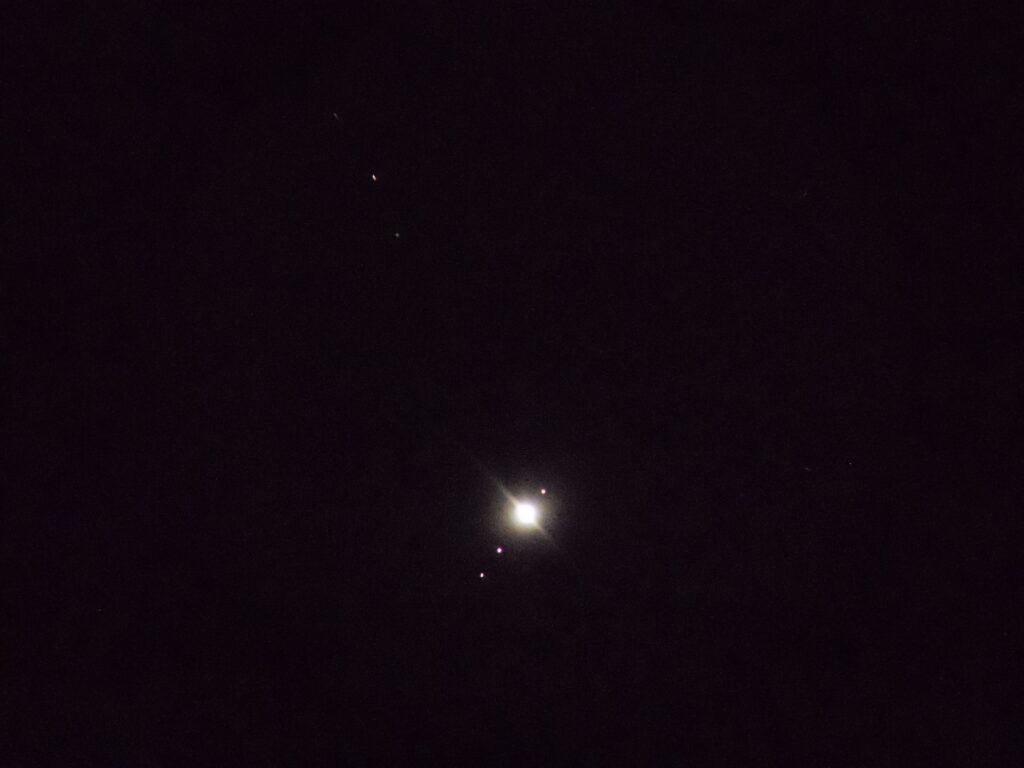Good Morning from my Robotics Lab! This is Shadow_8472, and today I have a follow up with my telescope. Let’s get started!
In contrast to recent years of drought and water rationing, this winter has seen the blessing of much-needed rain. Overcast often blocks out the night sky, and mist can ruin a clear night anyway. But Tuesday night this last week was clear, dry, and still. I took my entry-level telescope to the front yard.
One of my goals with telescope is photography. I wanted a modestly decent picture of Saturn before investing heavily in equipment. But Saturn is setting too soon after sunset to catch above my suburban skyline – Jupiter will have to do; before try that again, I want to get some good detail on the moon because my first attempt at astrophotography with a modified chair bracket failed when I couldn’t line up my small, pre-smartphone era camera well enough to locate the planetary system.
This time, I aligned everything before going outside and happened to aim the the parts I was holding at a floor lamp. Camera’s screen showed an off-center circle, and I adjusted the bracket’s wing nuts and bolts until it was centered, but even that wasn’t enough. Unless the camera looks straight down the eyepiece, it gets these funny “shadows” along one side or the other. It’s like looking down a paper towel tube – done right, you see a circle of light in the middle of your vision. Rotate the tube either way that isn’t the axis, and you get this sharpened oval kind of shape before you get no light at all. The bracket as is takes care of tilting up and down, but I still have to worry about twisting left and right. My current setup also lets me vary how deep to drive the bolt, but that gets ugly with wing nuts and rotation and everything. This is all in addition to another joint with two degrees of freedom originally included with the cell phone mount.
Outside, the moon was not up, but Jupiter was sitting high in the western sky. I aligned my star scope on the planet, and when I looked through the eyepiece, three of the four Galilean Moons on display. (From an online tracker, I later learned Io was transiting in front of the planetary disk at the time.) Better yet I found them in my camera. I set a 10 second delay and captured this picture at around 9 PM on February 27, 2024 (Pacific Standard Time).

I followed up with seven additional images at a higher zoom; they fell victim to distortions I believe were related to rotational misalignment between the camera and eyepiece which weren’t as noticeable at the camera’s lower internal magnification.
- The ten second delay timer proved important as it took as long as eight seconds for the telescope to stop shaking after touching the camera.
- Focus on the telescope was also big on my mind with colors turning green or blue (asymmetrically from the misalignment, of course), and tiny adjustments were next to impossible with the knob jumping.
- Zoom in on the camera too far, and I get a lens error when it gets stuck (I used the 2x eyepiece for a chance at locating Jupiter with the 4x).
- And even then I couldn’t get a still image where Jupiter resolved as a circle – looking directly: I saw a disk; camera preview: disk; take picture: flare.
- I was also having to re-aim the telescope every two exposures to track Jupiter as it moved across the sky. After a couple pictures, I rotated the camera so manual tracking wasn’t on a diagonal relative to the screen.
Improvements
From here, I have a few ideas on how to improve my setup: I could further modify the bracket to make it easier to use by reducing the number of parts I need to keep track of simultaneously – possibly by designing and 3D printing a custom bracket. I do have ideas. Alternatively: I have completed my goal of planetary photography, so I might consider indulging in a sensor that connects directly to the telescope instead of an eyepiece. It would be a tough call between that and a tracking mount, but taking the setup to an area with less light pollution can only improve my results.
Takeaway
I am enjoying learning more about God’s Creation. Looking closely at my picture, I can see more points of light than the ones I know about. Are any of these smaller moons? I don’t know. Is that red star to the right actually a red dwarf, or is it a camera error? I don’t know. What are the limits of my optics? I still have much to learn about them, but the saying is that the more you look, the more you will see.
Final Question
Are you into astronomy? What advice would you give someone who’s just starting out?
I look forward to your answers the comments below or on my Socials!

